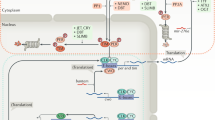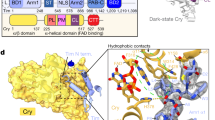Abstract
Biochemical studies indicate that the Drosophila timeless protein (Tim) is a stoichiometric partner of the period protein (Per) in fly head extracts. A Per-Tim heterodimeric complex explains the reciprocal autoregulation of the proteins on transcription. The complex is under clock control, and many circadian features of the Tim cycle resemble those of the Per cycle. However, Tim is rapidly degraded in the early morning or in response to light, releasing Per from the complex. The Per–Tim complex is a functional unit of the Drosophila circadian clock, and Tim degradation may be the initial response of the clock to light.
This is a preview of subscription content, access via your institution
Access options
Subscribe to this journal
Receive 51 print issues and online access
$199.00 per year
only $3.90 per issue
Buy this article
- Purchase on Springer Link
- Instant access to full article PDF
Prices may be subject to local taxes which are calculated during checkout
Similar content being viewed by others
References
Hall, J. C. Trends Neurosci. 18, 230–240 (1995).
Loros, J. The Neurosciences 7, 3–13 (1995).
Rosbash, M. Curr. Opin. Genet. Dev. 5, 662–668 (1995).
Takahashi, J. S. A. Rev. Neurosci. 18, 531–553 (1995).
Edery, I., Rutila, J. E. & Rosbash, M. Science 263, 237–240 (1994).
Konopka, R. J. & Benzer, S. Proc. natn. Acad. Sci. U.S.A. 68, 2112–2116 (1971).
Hardin, P. E., Hall, J. C. & Rosbash, M. Nature 343, 536–540 (1990).
Zerr, D. M., Hall, J. C., Rosbash, M. & Siwicki, K. K. J. Neurosci. 10, 2749–2762 (1990).
Edery, I., Zwiebel, L. J., Dembinska, M. E. & Rosbash, M. Proc. natn. Acad. Sci. U.S.A. 91(6), 2260–2264 (1994).
Hardin, P. E., Hall, J. C. & Rosbash, M. Proc. natn. Acad. Sci. U.S.A. 89, 11711–11715 (1992).
Zwiebel, L. J., Hardin, P. E., Liu, X., Hall, J. C. & Rosbash, M. Proc. natn. Acad. Sci. U.S.A. 88, 3882–3886 (1991).
Zeng, H., Hardin, P. E. & Rosbash, M. EMBO J. 13, 3590–3598 (1994).
Vosshall, L. B., Price, J. L., Sehgal, A., Saez, L. & Young, M. W. Science 263, 1606–1609 (1994).
Curtin, K., Huang, Z. J. & Rosbash, M. Neuron 14, 365–372 (1995).
Price, J. L., Dembinska, M. E., Young, M. W. & Rosbash, M. EMBO J. 14, 4044–4049 (1995).
Myers, M. P., Wager-Smith, K., Wesley, C. S., Young, M. W. & Sehgal, A. Science 270, 805–808 (1995).
Sehgal, A. et al. Science 270, 808–810 (1995).
Kay, S. A. & Millar, A. J. Cell 83, 361–364 (1995).
Reppert, S. M. & Sauman, I. Neuron 15, 983–986 (1995).
Sehgal, A., Price, J. L., Man, B. & Young, M. W. Science 263, 1603–1606 (1994).
Gekakis, N. et al. Science 270, 811–815 (1995).
Jackson, R. F., Bargiello, T. A., Yun, S.-H. & Young, M. W. Nature 320, 185–188 (1986).
Citri, Y. et al. Nature 326, 42–47 (1987).
Huang, Z. J., Edery, I. & Rosbash, M. Nature 364, 259–262 (1993).
Huang, Z. J., Curtin, K. & Rosbash, M. Science 267, 1169–1172 (1995).
Rutila, J. E., Edery, I., Hall, J. C. & Rosbash, M. J. Neurogenet. 8, 101–113 (1992).
Cleveland, D. W., Gischer, S. G., Kirschner, M. W. & Laemmli, U. K. J. biol. Chem. 252, 1102–1106 (1977).
Saunders, D. S., Gillanders, S. W. & Lewis, R. D. J. Insect Physiol. 40, 957–968 (1994).
Pittendrigh, C. S. in The Molecular Basis of Circadian Rhythms (eds Hastings, J. W. & Schweiger, H.-G.) 11–48 (Abakon, Berlin, 1976).
Crosthwaite, S. K., Loros, J. J. & Dunlap, J. C. Cell 81, 1003–1012 (1995).
Verma, I. M., Stevenson, J. K., Schwarz, E. M., Van Antwerp, D. & Miyamoto, S. Genes Dev. 9, 2723–2735 (1995).
Norbury, C. & Nurse, P. A. Rev. Biochem. 61, 441–470 (1992).
Jeffrey, P. C. et al. Nature 376, 313–320 (1995).
Siegel, L. M. & Monty, K. J. Biochim. biophys. Acta 112, 346–362 (1966).
Author information
Authors and Affiliations
Rights and permissions
About this article
Cite this article
Zeng, H., Qian, Z., Myers, M. et al. A light-entrainment mechanism for the Drosophila circadian clock. Nature 380, 129–135 (1996). https://doi.org/10.1038/380129a0
Received:
Accepted:
Issue Date:
DOI: https://doi.org/10.1038/380129a0
This article is cited by
-
Mechanical loading and hyperosmolarity as a daily resetting cue for skeletal circadian clocks
Nature Communications (2023)
-
Radical pairs can explain magnetic field and lithium effects on the circadian clock
Scientific Reports (2022)
-
Intrinsic disorder is an essential characteristic of components in the conserved circadian circuit
Cell Communication and Signaling (2020)
-
Circadian and Genetic Modulation of Visually-Guided Navigation in Drosophila Larvae
Scientific Reports (2020)
-
Molecular mechanisms and physiological importance of circadian rhythms
Nature Reviews Molecular Cell Biology (2020)
Comments
By submitting a comment you agree to abide by our Terms and Community Guidelines. If you find something abusive or that does not comply with our terms or guidelines please flag it as inappropriate.



